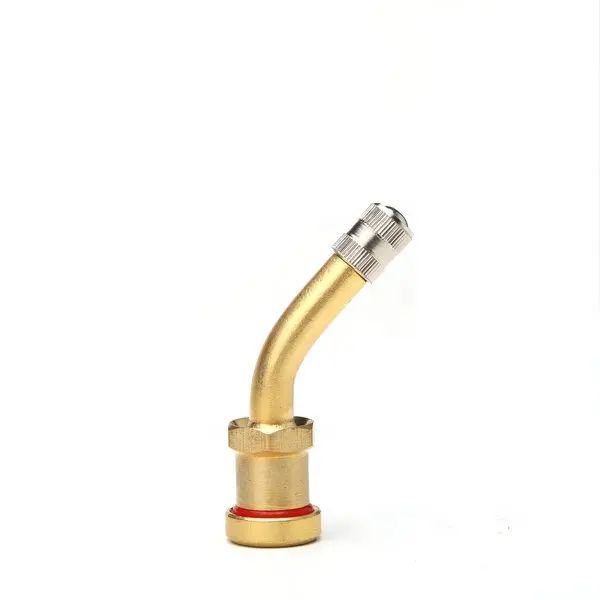Understanding Tubeless Tire Valves: Essential Components for Modern Tires
2025-04-11
In the world of automotive technology, tires play a crucial role in ensuring safety, comfort, and performance. Over the years, tire technology has evolved significantly, with tubeless tires becoming the standard for most vehicles. One of the key components that make tubeless tires efficient and reliable is the tubeless tire valve. Though small in size, the tire valve serves a critical function in maintaining tire pressure and performance.
In this blog, we will explore what tubeless tire valves are, how they work, their types, and why they are so important in modern tire systems.
What is a Tubeless Tire Valve?
A tubeless tire valve is a specialized valve used in tubeless tires, which are tires designed to hold air without the need for an inner tube. Unlike traditional tires that use an inner tube to maintain pressure, tubeless tires have a sealed design that relies on the tire itself to hold air. The tire valve is an essential part of this system, allowing for the inflation and deflation of the tire while maintaining the airtight seal.
The tubeless tire valve is typically located at the center of the wheel rim and consists of a valve stem, valve core, and a rubber or metal housing. Its primary function is to allow air to be pumped into the tire and to ensure that the air stays inside without leaking. In addition to providing a tight seal, the valve also plays a role in maintaining the correct tire pressure, which is crucial for vehicle safety and tire longevity.
How Does a Tubeless Tire Valve Work?
The tubeless tire valve works by allowing air to enter the tire and maintaining the air pressure over time. Here's how the system functions:
1. Inflating the Tire: When air is pumped into the valve, it flows through the valve stem and into the tire. The valve core inside the valve stem opens to allow air to enter the tire while preventing air from escaping. The valve stem itself is secured to the wheel rim, creating an airtight seal between the tire and the rim.
2. Maintaining Tire Pressure: Once the tire is inflated, the valve core closes to seal the valve, keeping the air inside the tire. This prevents air from escaping, which is crucial for maintaining the correct tire pressure. A well-maintained tire valve ensures that the tire holds its pressure for an extended period, reducing the need for frequent inflation.
3. Deflation and Maintenance: If the tire needs to be deflated, the valve core can be unscrewed slightly to allow air to escape. This is useful for adjusting tire pressure or for replacing the valve in the event of damage or wear. The valve can also be used to check tire pressure with a tire pressure gauge.
Types of Tubeless Tire Valves
There are various types of tubeless tire valves designed for different applications. The most common types include:
1. Rubber Tubeless Tire Valves
Rubber tubeless tire valves are the most common type found in passenger vehicles, motorcycles, and bicycles. These valves are made of flexible rubber and are designed to fit snugly into the wheel rim. The rubber material provides an excellent seal, preventing air from escaping. Rubber valves are typically cost-effective and easy to install, making them a popular choice for everyday vehicles.
2. Metal Tubeless Tire Valves
Metal tubeless tire valves are often used in heavy-duty vehicles, such as trucks, buses, and commercial vehicles. These valves are made from durable metal materials, such as brass or stainless steel, and are more resistant to damage from external factors such as heat, dirt, and road debris. Metal valves are typically more robust and can withstand higher pressure, making them suitable for larger and more demanding vehicles.
3. High-Performance Tubeless Tire Valves
High-performance tire valves are designed for vehicles that require more specialized features, such as racing cars or performance motorcycles. These valves often incorporate advanced materials like aluminum and are designed to handle higher pressures and speeds. They may also feature unique designs for improved aerodynamics and faster tire pressure adjustments.
4. Presta and Schrader Valves
Presta and Schrader valves are two common valve types used in bicycles, though they can also be found in some vehicles. The Presta valve is narrower and typically used in high-performance bicycles, while the Schrader valve is wider and more commonly found in cars and standard bicycles. Both valve types function in a similar way, with the primary difference being their size and design.
Why Are Tubeless Tire Valves Important?
Tubeless tire valves are more than just a part of the tire—they play a significant role in the overall performance, safety, and longevity of a vehicle. Here are some reasons why tubeless tire valves are so important:
1. Maintaining Proper Tire Pressure
Proper tire pressure is critical for vehicle safety, fuel efficiency, and tire lifespan. A tubeless tire valve ensures that the tire stays properly inflated by providing a secure seal, preventing air loss. Maintaining the correct tire pressure also improves handling, reduces tire wear, and maximizes fuel economy.
2. Reducing the Risk of Flats
One of the key benefits of tubeless tires is their ability to self-seal small punctures. The tubeless tire valve contributes to this process by ensuring that air stays inside the tire even if a small object punctures the tread. In some cases, the tire will automatically seal itself, allowing the vehicle to continue driving without needing an immediate tire change.
3. Enhanced Safety
A properly functioning tire valve helps prevent tire blowouts by maintaining the tire’s pressure within the optimal range. Underinflated tires can lead to dangerous situations, such as poor handling, reduced traction, and increased risk of tire failure. Tubeless tire valves ensure that tires stay inflated properly, minimizing these risks.
4. Easy Maintenance and Convenience
Tubeless tire valves make it easy to check and adjust tire pressure. Unlike traditional tube tires, which require removing the inner tube to inspect or adjust the pressure, tubeless tires allow for quick and convenient inflation through the valve. This feature is especially beneficial for vehicles that require regular tire maintenance or long-distance travel.
5. Durability and Longevity
Since tubeless tires are designed to be more durable and resilient than traditional tires, the valve itself must also be sturdy. Tubeless tire valves are made from materials that can withstand the rigors of daily driving, temperature changes, and exposure to harsh elements, ensuring they last as long as the tires themselves.
Conclusion
Tubeless tire valves may seem like a small and unassuming component, but they play a vital role in ensuring the safety, performance, and longevity of modern tires. Whether you're driving a car, riding a motorcycle, or cycling, these valves help maintain the right tire pressure, prevent air loss, and contribute to smoother, safer rides. Understanding how tubeless tire valves work and their importance can help you appreciate their role in modern vehicle design and maintenance.



